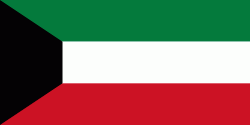Al Jahra Governorate (Muḩāfaz̧at al Jahrā’)
Al-Jahra Governorate (محافظة الجهراء Muḥāfaẓat al-Ǧahrāʾ) is one of the six Governorates of Kuwait. It is the largest Governorate in Kuwait. It includes the town of Al-Jahra, most of the northern and western parts of Kuwait, several islands (among them Bubiyan Island), and also western suburbs of Kuwait City. It also contains most of Kuwait's arable land. Jahra also has some historic relevance to Kuwait's history. The Red Palace or Al Qasr Al Ahmar is the most important historical landmark there.
Historically, Jahra was an agricultural oasis village and most Jahrans were farmers. Jahra's most notable residents included Sheikh Thuwainy Bin Abdullah Al-Saadoun (Sheikh of Al-Muntafiq) in 1786, when he fled from Baghdad to Suleiman Pasha. He wanted to occupy Basra and Sheikh Abdullah Al-Sabah hosted him until he returned to Baghdad after he was pardoned by the Iraqi governor. In 1925, Al Jahra administratively followed Kuwait City, and the population lived on the cultivation of palm trees and a little wheat and barley. Al Jahra contained 170 houses including the palace of Pasha al-Naqib and the palace of the Mubarak Al-Sabah. Nowadays Jahra is a modern city and farming has been reduced to various small farms. The geographic midpoint of Kuwait is located in this governorate.
* Alabdally
* Albhaith
* Aljahra
* Alkhwaisat
* Almutlaa
* Alnaeem
* Alnaseem
* Aloyoon
Historically, Jahra was an agricultural oasis village and most Jahrans were farmers. Jahra's most notable residents included Sheikh Thuwainy Bin Abdullah Al-Saadoun (Sheikh of Al-Muntafiq) in 1786, when he fled from Baghdad to Suleiman Pasha. He wanted to occupy Basra and Sheikh Abdullah Al-Sabah hosted him until he returned to Baghdad after he was pardoned by the Iraqi governor. In 1925, Al Jahra administratively followed Kuwait City, and the population lived on the cultivation of palm trees and a little wheat and barley. Al Jahra contained 170 houses including the palace of Pasha al-Naqib and the palace of the Mubarak Al-Sabah. Nowadays Jahra is a modern city and farming has been reduced to various small farms. The geographic midpoint of Kuwait is located in this governorate.
* Alabdally
* Albhaith
* Aljahra
* Alkhwaisat
* Almutlaa
* Alnaeem
* Alnaseem
* Aloyoon
Map - Al Jahra Governorate (Muḩāfaz̧at al Jahrā’)
Map
Country - Kuwait
 |
 |
| Flag of Kuwait | |
Historically, most of present-day Kuwait was part of ancient Mesopotamia. Pre-oil Kuwait was a strategic trade port between Mesopotamia, Persia and India. Oil reserves were discovered in commercial quantities in 1938. In 1946, crude oil was exported for the first time. From 1946 to 1982, the country underwent large-scale modernization, largely based on income from oil production. In the 1980s, Kuwait experienced a period of geopolitical instability and an economic crisis following the stock market crash. In 1990, after oil production disputes with neighbouring Iraq, Kuwait was invaded, and later annexed into one of Iraq's governorates by Iraq under Saddam Hussein. The Iraqi occupation of Kuwait came to an end on February 26, 1991, after military intervention by a military coalition led by the United States and various other countries.
Currency / Language
| ISO | Currency | Symbol | Significant figures |
|---|---|---|---|
| KWD | Kuwaiti dinar | دك | 3 |
| ISO | Language |
|---|---|
| AR | Arabic language |
| EN | English language |















